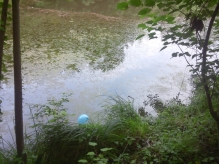As Tito has posted, our friend Simon Piggott passed away on 8th June. By chance, on the day I heard of his passing I had started reading Before the Dawn, a translation of Shimazaki Tōson’s (島崎藤村) 1929 novel Yoake-mae『夜明け前』. Following Simon’s example, I was trying to read more literature on paper — one of his great loves, in multiple languages. When I returned to it a week later, I found the following passage about two old friends in Magome, which seemed remarkably apt in a number of ways, the most obvious being that it is set in the Kiso valley of the Nakasendō 中山道, the Nagano post-town route that was the setting for the Hailstone Autumn Haike in October 2004, and on which Tito first introduced me to Simon.
A mound topped by a stone inscribed with a verse by Basho was set up beside the road in Shinjaya hamlet at the western edge of Magome.
Few things had ever given Kichizaemon such a strong sense of his life in a mountain village. Saying that the stonecutter was almost finished, Kimbei invited Kichizaemon to inspect the work on the mound. The two of them set out, dressed in the baggy trousers of mountain men.
“My father was fond of haikai. He always used to say that he intended to set up a Basho memorial during his lifetime. So I got the idea of doing it myself in remembrance of my father,” said Kimbei as he took Kichizaemon up to the memorial. Kichizaemon looked closely at the finished stone. There was an inscription on it.
送られつ送りつ果ては木曽の穐
Okuraretsu / okuritsu hate wa / Kiso no aki
After being seen
Off, and seeing off:
The Kiso autumn.芭蕉 Basho
“It’s beautifully written.”
“I’m not altogether pleased with the character for ‘autumn [穐],’” Kimbei remarked. “The left side is a cursive form of the grain radical and the right side is ‘tortoise.’ Right?”
“Well, some people do write it that way.”
“But in cursive, the grain radical looks much like the insect radical [虫] and now everyone will read it as ‘The Kiso houseflies [hae 蝿].’”
[…]
The Basho memorial was dedicated at the beginning of the fourth month of the year. Unfortunately, it was an overcast day and rain fell from mid-afternoon on. The invited guests were for the most part members of the haikai circle from Mino and they brought rustic gifts. Some brought fans and bean candy, others brought fresh oak mushrooms, and one even brought a box of the tiny rice crackers known as “hailstones [arare あられ、霰],” of which he said Kimbei’s father had been particularly fond. When they had all gathered at Kimbei’s place, the people and the accents of two provinces blended together. In the company was the haikai master and priest Susa, who came from Ochiai, the next post station down from the pass. Thanks to him, the Mino group was able to carry on linked-verse sessions in a setting appropriate to the school of Kagami Shiko, with actual samples of Shiko’s calligraphy hung on the walls.
Since Kimbei was acting as host and could not participate directly in the composition of fifty or hundred line linked verse, he passed around lavish refreshments and plied his guests with sake.
Everyone had planned to gather at the foot of the newly constructed mound to conduct a memorial service and to chant verses. But since it took until dusk to complete the day’s linked verse, the chanting was done at Kimbei’s house. Only the memorial service was held at Shinjaya.
Kimbei, who scrupulously followed the old customs, later went all the way down to Ochiai to present a brown-striped, cotton-filled winter jacket to the haikai master Susa, to thank him for presiding over the day’s poetry composition. Kimbei told Susa that it had once belonged to his father.
“You really are my best friend,” Kichizaemon told Kimbei that day.
Before the Dawn is William E. Naff’s English translation of Yoake-mae (University of Hawai’i Press, 1987). The excerpts are from pp. 12-14.





























